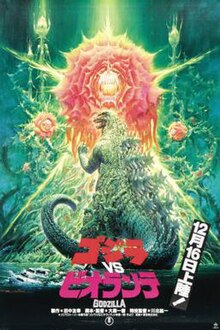| Godzilla vs. Biollante | |||||
|---|---|---|---|---|---|
 Theatrical release poster by Noriyoshi Ohrai | |||||
| Japanese name | |||||
| Katakana | ゴジラvsビオランテ | ||||
| |||||
| Directed by | Kazuki Ōmori | ||||
| Screenplay by | Kazuki Ōmori | ||||
| Story by | Shinichirō Kobayashi | ||||
| Produced by | Shōgo Tomiyama Tomoyuki Tanaka | ||||
| Starring | |||||
| Cinematography | Yūdai Katō | ||||
| Edited by | Michiko Ikeda | ||||
| Music by | Koichi Sugiyama | ||||
Production company | |||||
| Distributed by | Toho | ||||
Release date |
| ||||
Running time | 104 minutes | ||||
| Country | Japan | ||||
| Languages | Japanese English | ||||
| Budget | ¥700 million[1] ($10.7 million)[2] | ||||
| Box office | ¥1.04 billion[3] | ||||
Godzilla vs. Biollante (ゴジラvsビオランテ, Gojira tai Biorante)[a] is a 1989 Japanese kaiju film directed and written by Kazuki Ōmori, with special effects by Kōichi Kawakita. Distributed by Toho and produced under their subsidiary Toho Pictures, it is the 17th film in the Godzilla franchise, the second film in the franchise's Heisei period, and a sequel to 1984's The Return of Godzilla. The film stars Kunihiko Mitamura, Yoshiko Tanaka, Masanobu Takashima, Megumi Odaka, Toru Minegishi, Yasuko Sawaguchi, Toshiyuki Nagashima, Yoshiko Kuga, Ryunosuke Kaneda and Kōji Takahashi. This was Odaka's first appearance in the Godzilla franchise as Miki Saegusa, and would reprise the role in every film for the remainder of the Heisei series.
In the film, corporations struggle for control over samples of Godzilla's cells, while the monster itself battles a creature born from a combination of Godzilla's cells, the cells of a plant, and the cells of a woman. The idea originated from a public story-writing contest, and set a trend common to all Heisei era movies, in which Godzilla faces off against opponents capable of metamorphosing into new, progressively more powerful forms.[4]
Godzilla vs. Biollante was released theatrically in Japan on December 16, 1989. It received generally positive reviews who praised the storyline, visual effects, and Sugiyama's score, but was a disappointment at the Japanese box office due to competition with Back to the Future Part II. It received a direct-to-video release in the United States on November 25, 1992, through HBO Video.[5][6]
It was followed by Godzilla vs. King Ghidorah which was released on December 14, 1991.
- ^ Iwabatake, Toshiaki (September 1, 1994). Terebi Magajin Tokubetsu Henshū Tanjō 40 Shūnenkinen Gojira Taizenshū [TV Magazine Special Edition 40th Anniversary of the Birth of Godzilla Complete Works]. Kodansha. pp. 76–77. ISBN 4-06-178417-X.
- ^ a b Associated Press (December 14, 1989). "Ready for Godzilla XVII?". The Arizona Republic. p. 39. Retrieved February 25, 2024 – via Newspapers.com.
It cost $10.7 million, making it the most expensive Godzilla movie ever.
- ^ "List of Godzilla Movies". Nenda Ryuukou. Retrieved 5 July 2021.
- ^ Cite error: The named reference
ryfle1998was invoked but never defined (see the help page). - ^ Koichi Kawakita, ed. (2012-02-01). 平成ゴジラパーフェクション. DENGEKI HOBBY BOOKS (in Japanese). ASCII Media Works. p. 147. ISBN 978-4048861199.
- ^ Toho Co., Ltd. (2012-09-28). 東宝特撮映画大全集 (in Japanese). villagebooks inc. p. 227. ISBN 978-4864910132.
Cite error: There are <ref group=lower-alpha> tags or {{efn}} templates on this page, but the references will not show without a {{reflist|group=lower-alpha}} template or {{notelist}} template (see the help page).